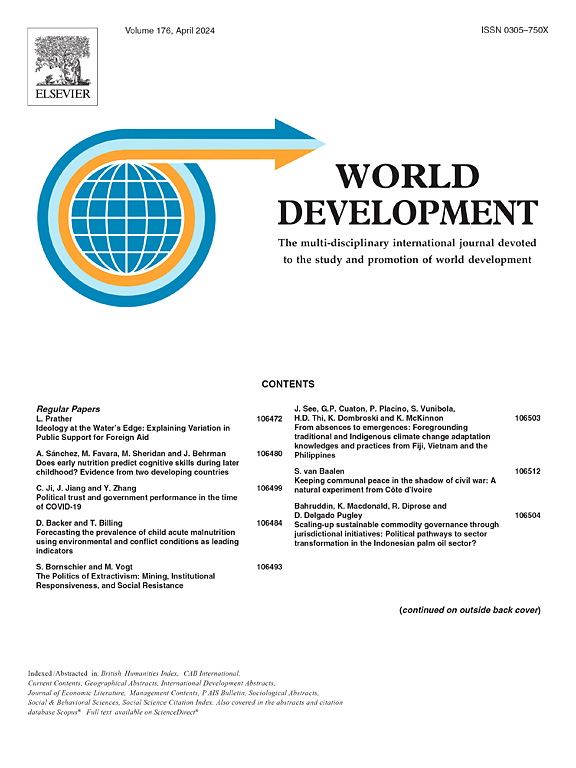Contracts and effective Inter-Organizational Collaboration: The case of the Galápagos Wind partnership
IF 5.4
1区 经济学
Q1 DEVELOPMENT STUDIES
引用次数: 0
Abstract
Over the past three decades, the establishment of partnerships between public and non-state actors has become a leading mechanism of inter-organizational collaboration for sustainable development. The presence of productive collaboration inside a partnership, as well as a partnership’s ability to influence collaboration and institutions outside the immediate partners, are usually considered important pathways to partnership effectiveness. The conditions which facilitate or undermine such collaboration, however, are still widely debated. In this article, we draw on the literature on institutional and partnerships effectiveness to explore how the institutional design of a partnership, and more specifically the quality of its contractual arrangements, may influence the ability of the partners to come together, articulate partnership goals, gain access to additional sources of financing, and manage reputational risks and gains. We do so through a case study of the Galápagos San Cristóbal Wind Project partnership, which was established in 2003 to reduce the Galápagos Islands’ dependence on imported fossil fuels, while simultaneously protecting the region’s fragile marine ecosystem from the risk of oil spills and contributing toward the transition to cleaner energy sources. Overall, we find that the high quality of contracting used in the partnership, including the supporting role of domestic legislation, was instrumental in shaping the effectiveness of the project activities and also served as a catalyst to facilitate adaptability and the credible commitment of resources by the partners. While we note the importance of considering contextual factors and conditions before applying our findings to other types of more informal collaborative relationships, we argue that the theoretical focus on contractual arrangements emphasized in our article is likely to remain important for understanding the effectiveness of global partnerships for sustainable development.
合同和有效的组织间协作:Galápagos Wind伙伴关系的案例
在过去三十年中,在公共和非国家行为体之间建立伙伴关系已成为促进可持续发展的组织间合作的主要机制。伙伴关系内部是否存在富有成效的协作,以及伙伴关系对直接伙伴以外的协作和机构产生影响的能力,通常被认为是提高伙伴关系效力的重要途径。然而,促进或破坏这种合作的条件仍然存在广泛的争论。在本文中,我们借鉴了有关制度和伙伴关系有效性的文献,探讨了伙伴关系的制度设计,更具体地说,是其合同安排的质量,如何影响合作伙伴走到一起、阐明伙伴关系目标、获得额外融资来源以及管理声誉风险和收益的能力。我们通过对Galápagos San Cristóbal风能项目伙伴关系的案例研究来做到这一点,该项目于2003年建立,旨在减少Galápagos群岛对进口化石燃料的依赖,同时保护该地区脆弱的海洋生态系统免受石油泄漏的风险,并为向清洁能源的过渡做出贡献。总体而言,我们发现伙伴关系中使用的高质量合同,包括国内立法的支持作用,在塑造项目活动的有效性方面发挥了重要作用,也成为促进合作伙伴对资源的适应性和可信承诺的催化剂。虽然我们注意到在将我们的研究结果应用于其他类型的非正式合作关系之前考虑情境因素和条件的重要性,但我们认为,我们文章中强调的对契约安排的理论关注可能对理解全球可持续发展伙伴关系的有效性仍然很重要。
本文章由计算机程序翻译,如有差异,请以英文原文为准。
求助全文
约1分钟内获得全文
求助全文
来源期刊

World Development
Multiple-
CiteScore
12.70
自引率
5.80%
发文量
320
期刊介绍:
World Development is a multi-disciplinary monthly journal of development studies. It seeks to explore ways of improving standards of living, and the human condition generally, by examining potential solutions to problems such as: poverty, unemployment, malnutrition, disease, lack of shelter, environmental degradation, inadequate scientific and technological resources, trade and payments imbalances, international debt, gender and ethnic discrimination, militarism and civil conflict, and lack of popular participation in economic and political life. Contributions offer constructive ideas and analysis, and highlight the lessons to be learned from the experiences of different nations, societies, and economies.
 求助内容:
求助内容: 应助结果提醒方式:
应助结果提醒方式:


